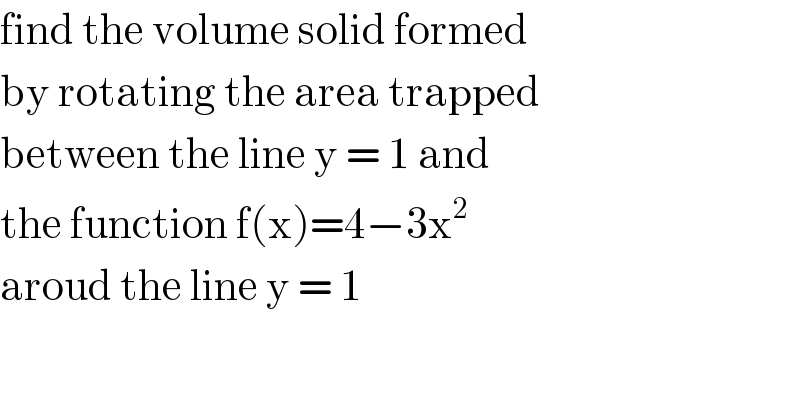Question Number 90443 by jagoll last updated on 23/Apr/20

$$\mathrm{find}\:\mathrm{the}\:\mathrm{volume}\:\mathrm{solid}\:\mathrm{formed} \\ $$$$\mathrm{by}\:\mathrm{rotating}\:\mathrm{the}\:\mathrm{area}\:\mathrm{trapped} \\ $$$$\mathrm{between}\:\mathrm{the}\:\mathrm{line}\:\mathrm{y}\:=\:\mathrm{1}\:\mathrm{and} \\ $$$$\mathrm{the}\:\mathrm{function}\:\mathrm{f}\left(\mathrm{x}\right)=\mathrm{4}−\mathrm{3x}^{\mathrm{2}} \\ $$$$\mathrm{aroud}\:\mathrm{the}\:\mathrm{line}\:\mathrm{y}\:=\:\mathrm{1} \\ $$
Commented by john santu last updated on 23/Apr/20
![the intersection point of the line y = 1 with curve of y=4−3x^2 . ⇒1=4−3x^2 x = ± 1. vol = π ∫_(−1) ^( 1) R(x)^2 dx with R(x)= f(x)−1 = 3−3x^2 vol = 2π∫_0 ^1 (3−3x^2 )^2 dx vol = 18π ∫_0 ^1 (1−2x^2 +x^4 ) dx = 18π [ x−(2/3)x^3 +(1/5)x^5 ]_0 ^1 = 18π [ 1−(2/3)+(1/5) ] = 18π [ (8/(15))] = ((144π)/(15))](https://www.tinkutara.com/question/Q90444.png)
$${the}\:{intersection}\:{point}\:{of}\:{the} \\ $$$${line}\:{y}\:=\:\mathrm{1}\:{with}\:{curve}\:{of}\: \\ $$$${y}=\mathrm{4}−\mathrm{3}{x}^{\mathrm{2}} \:.\:\Rightarrow\mathrm{1}=\mathrm{4}−\mathrm{3}{x}^{\mathrm{2}} \\ $$$${x}\:=\:\pm\:\mathrm{1}.\:{vol}\:=\:\pi\:\int_{−\mathrm{1}} ^{\:\:\mathrm{1}} {R}\left({x}\right)^{\mathrm{2}} \:{dx} \\ $$$${with}\:{R}\left({x}\right)=\:{f}\left({x}\right)−\mathrm{1}\:=\:\mathrm{3}−\mathrm{3}{x}^{\mathrm{2}} \\ $$$${vol}\:=\:\mathrm{2}\pi\underset{\mathrm{0}} {\overset{\mathrm{1}} {\int}}\:\left(\mathrm{3}−\mathrm{3}{x}^{\mathrm{2}} \right)^{\mathrm{2}} \:{dx}\: \\ $$$${vol}\:=\:\mathrm{18}\pi\:\underset{\mathrm{0}} {\overset{\mathrm{1}} {\int}}\left(\mathrm{1}−\mathrm{2}{x}^{\mathrm{2}} +{x}^{\mathrm{4}} \right)\:{dx} \\ $$$$=\:\mathrm{18}\pi\:\left[\:{x}−\frac{\mathrm{2}}{\mathrm{3}}{x}^{\mathrm{3}} +\frac{\mathrm{1}}{\mathrm{5}}{x}^{\mathrm{5}} \:\right]_{\mathrm{0}} ^{\mathrm{1}} \\ $$$$=\:\mathrm{18}\pi\:\left[\:\mathrm{1}−\frac{\mathrm{2}}{\mathrm{3}}+\frac{\mathrm{1}}{\mathrm{5}}\:\right] \\ $$$$=\:\mathrm{18}\pi\:\left[\:\frac{\mathrm{8}}{\mathrm{15}}\right]\:=\:\frac{\mathrm{144}\pi}{\mathrm{15}} \\ $$
Commented by john santu last updated on 23/Apr/20

Commented by jagoll last updated on 23/Apr/20

$$\mathrm{thank}\:\mathrm{you} \\ $$
